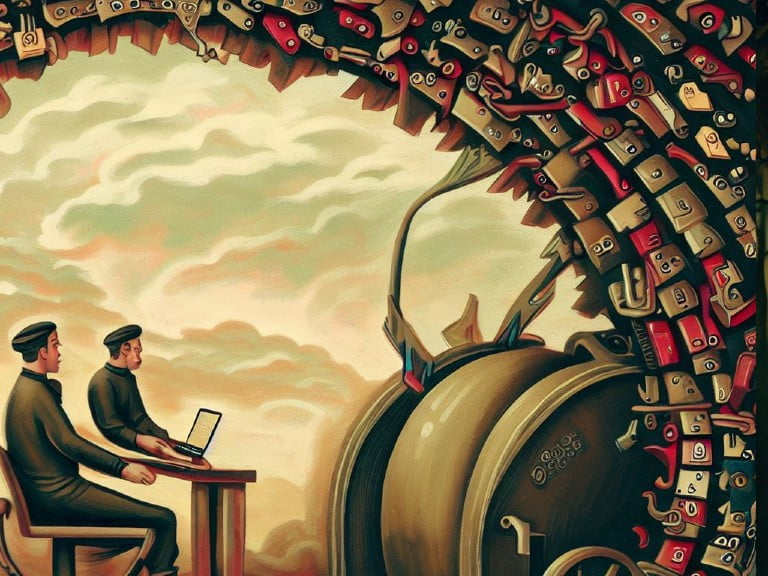Welcome to the vibrant world of UTM tags in our dive into the fascinating universe of UTM tags—your new best friend (don’t tell your dog!) for slicing through the digital marketing fog. If you’re spinning up content, launching campaigns, or just want to geek out on user tracking and personalisation, getting a grip on UTM tags is like unlocking a cheat-code to unlock maximum capability.
With that, let’s crack into what UTM tags are, scoop up their benefits, and master using them across your platforms. We’ll even cover a few advanced hacks to get a little bit of that sweet cross-platform audience unification action happening.
What are UTM Tags?
UTM tags, are simple additions to a URLs that give your links super-powers, such as the ability to track the effectiveness of campaigns across traffic sources, to evaluate the quality of traffic being sent to your site by affiliates or influencers, or even the volume of traffic being sent form your own collateral, such as PDFs or QR codes on products you send to customers.
Now, as a quick aside for those of you who have the appetite for a new conversation starter, you might be wondering what the UTM stands for, and that is Urchin Tracking Module. Why? Back in the early days of Web Analytics, there was a small company called Urchin Analytics that, thanks to Google purchasing them, eventually became the Google Analytics of today!
Names and acronyms aside, the key takeaway is that UTM tags help clarify exactly which traffic sources brought visitors to your site, and which links they are associated with, making them indispensable for those of us who rely on data-driven strategies to make decisions for audience creation, media spend allocation, and ultimately, improving what and how we deliver our core business output to our customers.

Now, I mentioned that UTM tags are used to describe things about which links out in the wild web drove a user to your site. To achieve that, we have the capability to include up to five of these UTM tags, each used for a different piece of information, though not all need to be used in every case:
- utm_source: This identifies the source of the traffic, such as a PDF, email, or other place (outside of your own site) your links might appear on the web. You can think of this as the ‘WHERE‘ in our sequence of options.
- utm_medium: This specifies the medium used to publish the link, such as email, CPC, or other methods of distribution. Think of this as ‘HOW‘ the link got in front of people – was it paid or organic, or perhaps newsletter email.
- utm_campaign: This differentiates the campaigns that direct traffic, helping us measure the effectiveness of each campaign. As always, we need a ‘WHY‘, and this tag answers that (for instance, ‘Black Friday Hype’.
- utm_term: Employed predominantly in paid search, this tracks the keywords for which you’ve optimized the ad. With that said, you can use this as a field you can populate with relevant information, such as the audience of an EDM campaign.
- utm_content: This can identify which version of an advertisement or link was more effective in bringing traffic, useful in A/B testing scenarios. Think of this as your ‘WHAT‘ in our sequence of options.
An example of a UTM-tagged URL might look like this:
http://www.neobadger.com?utm_source=offline-billboard&utm_medium=qr-code&utm_campaign=massive-tea-sale&utm_content=tasmania-everyone-is-family-v2When a user clicks on this URL, we can see that they were directed from our offline billboard (source) via a QR code (medium), part of our Massive Tea Sale (campaign). The billboard featured the ‘Everyone is Family’ design (content) displayed in Tasmania.
Benefits of Using UTM Tags
UTM tags transform URLs into powerful analytics tools, enabling you to track where visitors are coming from, how they are getting to your website, and whether certain campaigns are more effective than others. By using UTM tags, we can obtain a detailed map of their traffic sources, which helps in optimizing marketing strategies and resource allocation.
Moreover, UTM data is invaluable for understanding user behavior, improving content relevance, and making real-time adjustments to marketing efforts. Utilizing UTM tags allows us to navigate the vast sea of data analytics with precision and ease, ensuring that every campaign’s effectiveness is measurable and, therefore, optimizable.
Tracking ROI and User Engagement
UTM tags enable you to quantify the return on investment (ROI) for each element of your marketing strategy by providing concrete data on how users are interacting with your links. This means you can see which channels bring the most traffic, which campaigns convert at higher rates, and where improvements can be made.
Improving Marketing Strategies
By understanding which campaigns perform best, you can use UTM-tagged data to refine your marketing strategies and use your budget more effectively. This data-driven approach ensures that your marketing efforts are not based on guesses but on real user engagement metrics.
Enhancing CRM Integration
Integrating UTM tags with customer relationship management (CRM) systems can dramatically improve how customer data is collected and utilized. We can track a customer’s initial point of contact and follow their interaction through to conversion, gaining insights into customer preferences and behavior that can inform future campaigns.
How to Use UTM Tags
It’s likely that, most of the time, you will be wanting to access your UTM data in Google Analytics, where it is used to populate the acquisition reports, which provide insights into traffic sources and user paths. To view these reports, select Acquisition and then Traffic acquisition; here you’ll see user interactions broken down by source, medium, campaign, and other dimensions.

This breakdown can help you understand which parts of your marketing strategy are working and which parts need adjustment. You can also click the plus (on the right of the ‘Session / source medium’ selector, as seen in the image above), and search for ‘Session campaign’, ‘Session manual ad content’, and ‘Session manual term’ to see the value of other parameters (though it’s worth filtering based on source or medium first).
Tips and Tricks for Creating Effective UTM Tags
Before you create your URL, I recommend that you pause for a moment and consider how you want the values you apply to your tags to appear in your reports when you consume them. Consider the case you use, the style, and the taxonomy you are going to use, and your future self will be very happy.
Once you have a scheme established, ensure you document it and socialise it so others can ensure your standards are met! Here are some general rules I follow when formulating a UTM tagging scheme:
1. Maintain Consistent Naming Conventions
Consistency in your UTM parameters is crucial to avoid discrepancies that can lead to data misinterpretation:
- Use Standardized UTM Parameters: Consistently using the same case (e.g., all lowercase) and format across your parameters (e.g. using spaces, snake case, or kabab case) will help keep your data clean and organized. This prevents issues like duplicated reports due to case sensitivity (e.g., ‘Google’ vs ‘google’).
- Create a UTM Template: A template acts as a guideline for your team, ensuring that everyone uses UTM tags that follow the same structure. This reduces errors and helps maintain data integrity across your campaigns.
2. Be Descriptive and Precise
The more specific your UTM tags, the more useful your traffic data will be:
- Choose Specific Names: Use tags that clearly describe the traffic source, medium, and campaign purpose. Specific names help you quickly identify successful campaigns and adjust strategies accordingly.
- Include Significant Details: Adding details like dates, locations, and other relevant information can enhance the granularity and usefulness of your data (but constrain this detail to lower-level UTM tags such as ‘campaign’, ‘term’ or ‘content’), making it easier to track performance over time or across different segments.
5. Regularly Audit Your UTM Practices
Regular audits help ensure that everyone is on the same page and that your data collection methods are accurate:
- Schedule Regular Reviews: Frequent checks allow you to correct any deviations from established UTM standards and adapt to any new marketing strategies.
- Update Documentation: Keeping your documentation up to date can serve as a reference point for your team and help onboard new members faster, ensuring consistency.
6. Leverage Automation Tools
Automation can greatly simplify the creation and management of UTM-tagged URLs:
- Use UTM Builders: Tools like the Google Campaign URL Builder provide a foolproof way to generate URLs with UTM tags by filling in a simple form, which helps eliminate manual errors.
- Implement Scripts for Bulk Creation: If you are dealing with large sets of URLs, using scripts or spreadsheet macros can automate the creation process, saving time and reducing the potential for mistakes.
7. Avoid Common Pitfalls
Knowing what to avoid is just as important as knowing what to do:
- Don’t Overcomplicate Tags: Simple, clear tags are easier to analyze and remember. Complicated tags can clutter your data and make analysis more difficult. Use higher level tags (such as ‘source’ and ‘medium’) as classification resources, not descriptors – that’s what ‘campaign’, ‘term’ or ‘content’ are for).
- Avoid Sensitive Information: UTM parameters are visible to anyone who looks at the URL, so never include confidential or sensitive information. This is absolutely essential for compliance with Google’s data collection polices, as well as with many regulations.
- Limit Use of Special Characters: Non-alphanumeric characters (other than hyphens and underscores) can cause issues with link functionality and tracking accuracy.
Creative Use Cases for UTM Data
So, we have come a for way in understanding what UTM tags are, why we use them, how to make them, and some best practices for making your own. You have everything you need to get started with unlocking the insights that UTM tags can provide. Let’s go one level further and explore some creative uses of UTM data to push their capabilities to heights often left unexplored by those who aren’t as enthusiastic (and nerdy) as we are!
Personalizing User Experience
By dynamically adjusting content based on the originating campaign, you can create a more personalized user experience. For instance, if a visitor comes from a UTM-tagged YouTube ad link associated with a particular campaign, you can ensure the user sees the same assets as what they saw in the ad.

This is particularly useful if you have different media assets based on your different audience segments as it allows for a more continuous experiential narrative to be formed that is tailored to what you know about the user who clicked on the link in the first place.
Creating Cross-Platform Audiences
UTM data is not just for tracking—it can also enhance audience segmentation for cross-platform campaigns. For example, by identifying which users clicked on a specific UTM-tagged link in an email, you can create a custom audience in Meta Ads Manager to target these users with specific advertisements (you might need to do a little magic in GTM, but it’s nothing complicated). This strategy uses established interest (demonstrated through the initial click) to tailor the advertising they see on social platforms, potentially increasing engagement rates.
Enhancing Offline Campaigns with QR Codes
UTM parameters aren’t confined to the digital realm; they can bridge the gap between online marketing and physical stores. By embedding UTM codes within QR codes on physical ads, we can trace the effectiveness of offline advertisements.
For instance, a QR code on a poster or even a product sample in your store can link to a campaign-specific landing page that tracks user engagement through UTM parameters, or to be used to build an audience, or even to personalise their experience on your site (as described above). This method provides precise data on how offline elements contribute to online traffic and conversions, offering a holistic view of campaign performance.
Final Thoughts
Wrapping up our detailed exploration into the world of UTM tags, we can confidently say that they are not just tools but essential allies in the realm of digital marketing. By integrating UTM tags into your URLs, you gain precise tracking capabilities that illuminate the pathways through which users arrive at your site, which campaigns strike a chord, and what content captures interest. This insight allows us to craft more targeted, data-driven campaigns that speak directly to the interests and needs of their audiences, potentially boosting engagement and conversions.

UTM tags offer a straightforward yet powerful way to segment audience data, refine marketing strategies, and ultimately, maximize return on investment. Whether you’re looking to enhance user experience, streamline CRM integration, or just get a clearer picture of your traffic sources, UTM tags provide the analytics prowess to make it happen. Remember, the key to effective UTM implementation lies in consistent, clear tagging practices coupled with regular audits and adjustments based on analytical insights.
As you move forward, use the creativity and flexibility that UTM parameters offer to experiment with new marketing techniques or optimize existing ones. From personalizing user interactions to bridging the gap between online and offline marketing efforts, the possibilities are nearly endless. By maintaining a curious and meticulous approach to data analysis with UTM tags, you can not only achieve your marketing goals but also discover innovative ways to exceed them, ensuring that every campaign is not just a launch, but a significant step towards greater success.
